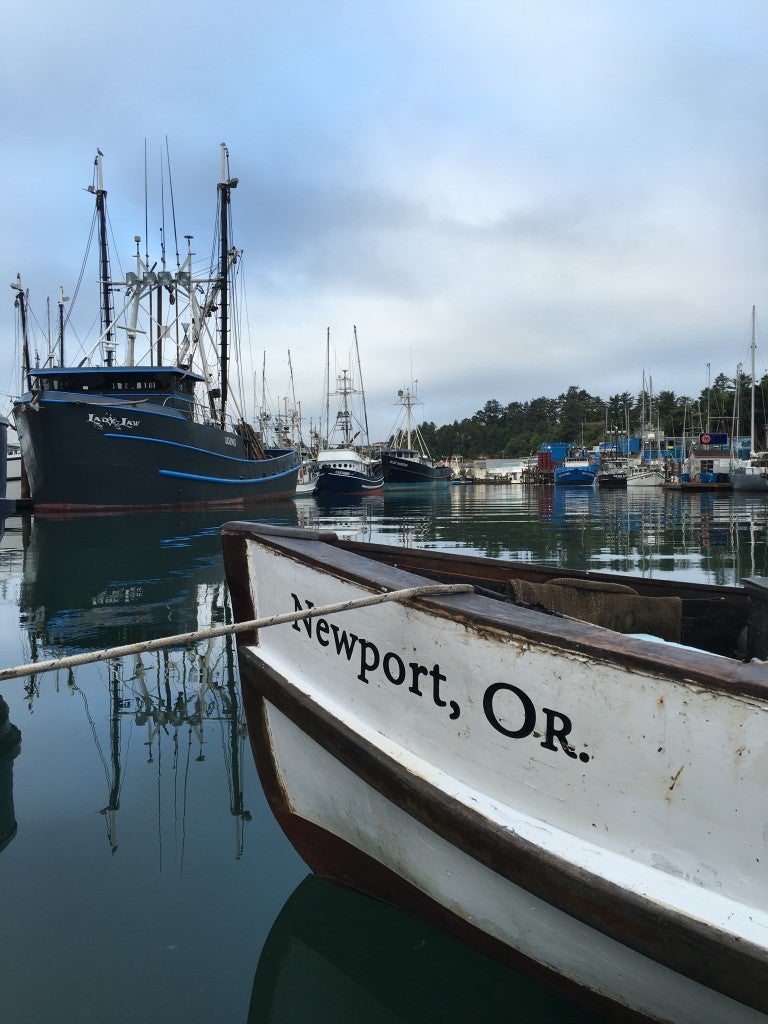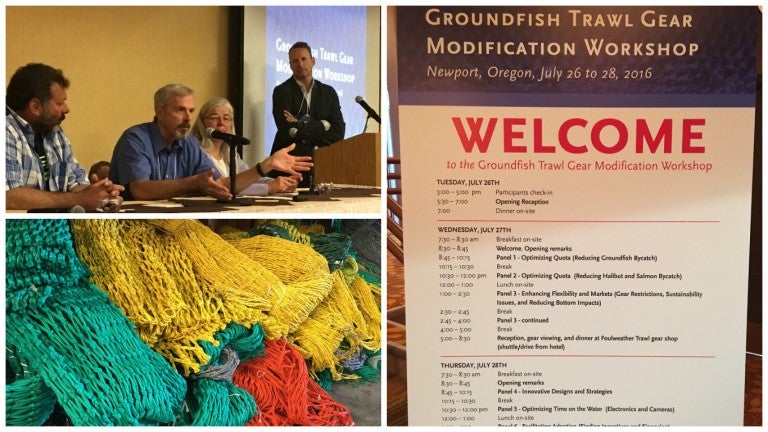“The best way to get something done is to tell a fisherman it can’t be done.”
so says Bob Dooley, veteran fisherman and industry leader.
This was the reason a two day conference on gear modification through innovation was convened according recently Oregon, USA where fishermen face exactly the same issues through restrictions on fishing effort as we do in the UK.
With support from a Saltonstall-Kennedy grant and the Packard Foundation, EDF’s Pacific team joined with an all-star Steering Committee this month to convene a Gear Modification Workshop in Newport, Oregon. More than 70 fishermen from the West Coast and Alaska, along with scientists, net manufacturers, fishery managers, electronics experts, NGO representatives and others came together for two very enjoyable days of intensive information sharing.
The West Coast groundfish trawl fishery is a laboratory of gear innovation these days because the catch share management system requires fishermen to account for every fish caught. Having operated under catch share systems for many years, Alaska fishermen and researchers brought their experiences to bear. Since unwanted or undersized fish count against a fisherman’s overall quota, the incentive to “fish clean” is much higher than in less-accountable fisheries. Fishermen are deploying underwater cameras and working with net manufacturers to design nets that fish more selectively, reduce bottom impact and save on fuel costs. Likewise, Alaska fishermen and researchers have long been leaders in gear innovation, and they brought their perspectives and expertise to share with their West Coast counterparts.
In one presentation, Giuseppe (Joe) Penissi of Monterey described the remarkable success he has had in modifying his trawl to release non-marketable juvenile fish, and fellow fisherman Steve Fitz was impressed. “I keep going back to what Joe’s doing, because his example today was perfect. He witnessed 40,000 pounds of fish move through his net and he kept 4,700 pounds, so what more could you ask for? That was 100% sustainable, marketable fish. That’s just a real win-win situation.”
Sara Skamser, owner of Foulweather Trawl, has been listening to fishermen and refining trawl designs for years. But not just fishermen. “In these changing times in fisheries, in modernizing the fleet, there’s a lot of partners besides ourselves that we work with. We work with scientists to quantify ideas that we have; they can go out and test it and tell us if it’s working. We work with EDF, with all kinds of people that have helped the fishermen understand the economic value of their fish, how to capitalize and get the most out of everything they’re bringing in from the ocean.”
Over the two days workshop participants discussed trawl-door spread, angle of attack, new materials for net design and a variety of other arcane topics, but in essence they were discussing the “half glass empty/half glass full” tensions that are created when fishermen are eager to innovate for efficiency and profitability, but must do so within the strictures posed by a slow-to-adapt overall management structure.
“The gear innovation that’s going on, all these changes, are really aided by this individual quota catch share program,” said Bob Dooley, veteran fisherman and industry leader. “When the currency of the fishery was catch all you can as quick as you can before somebody else shuts the fishery down, we didn’t have time to do this stuff.”
Although Bob Dooley’s comments reflected the positive overall vibe of the workshop, fisheries leader Heather Mann addressed the many longstanding problems with management of the West Coast groundfish fishery, including escalating costs and a Council process that requires years to resolve even non-controversial issues. “How do you innovate under that?” she asked. “How do you innovate when you operate in a bureaucratic morass that moves at a glacial pace? Until we fix some of these fundamental problems…we’re in an adapt-to-survive mode instead of an adapt-and thrive-mode.”
But on-the-water solutions to improve efficiency and profitability were the focus of the discussions. Some of them were downright futuristic, but low cost/low tech also had its place. Steve Fitz described his DIY GoPro system that rivals many more expensive designs. “I’m beginning to learn and understand things that I’ve only been able to assume were going on 600 feet below me, and now I’m able to get some visual evidence and adapt to it and make changes for the better.”
"I know this is the first time something like this has been done, but I think the response to this has been incredibly positive on a whole lot of levels.” – Carwyn Hammond, NOAA Research Fisheries Biologist
Overall, the workshop was a great way to “un-silo” information and spread the word about innovations that help fishermen be more efficient and profitable while reducing fuel costs, seafloor impacts and bycatch. Many attendees expressed the hope that we will develop more workshops in the future, and we certainly intend to do so. As the near-legendary net builder Sara Skamser said, “…the ideas bouncing around here are all just, wow! It’s been a perfect first step towards collaboration within the industry.”
Welcome to Through the Gaps, the UK fishing industry's most comprehensive information and image resource. Newlyn is England's largest fish market and where over 50 species are regularly landed from handline, trawl, net, ring net and pot vessels including #MSC Certified #Hake, #Cornish Sardine, handlined bass, pollack and mackerel. Art work, graphics and digital fishing industry images available from stock or on commission.

